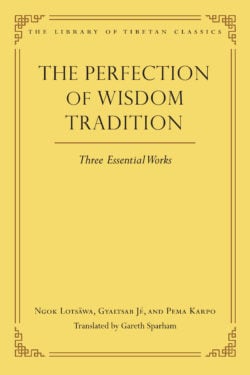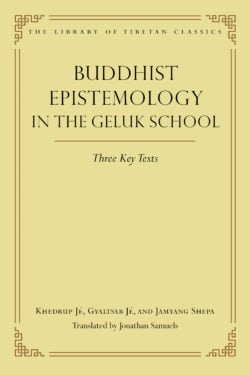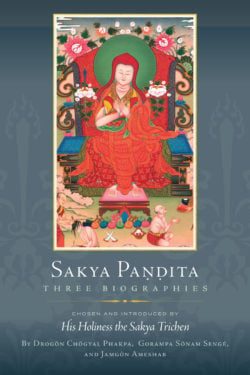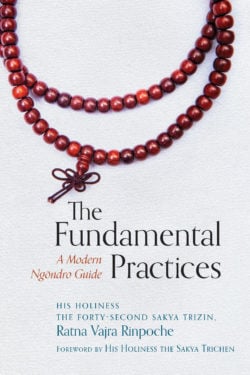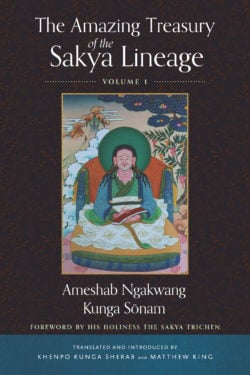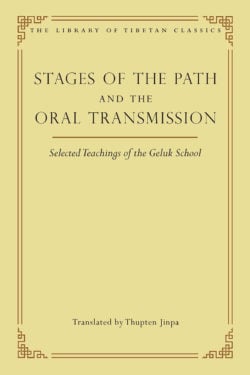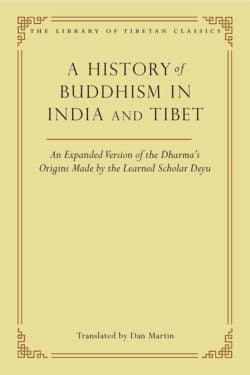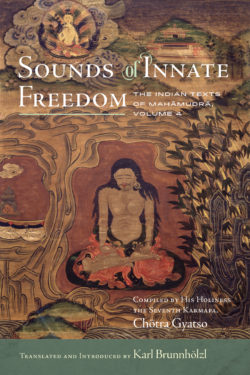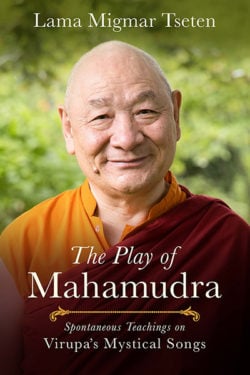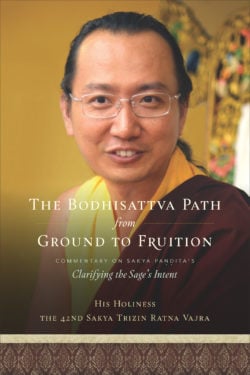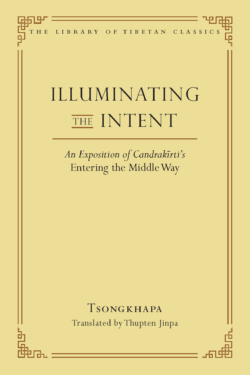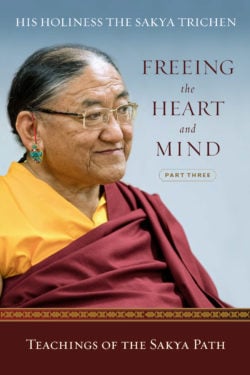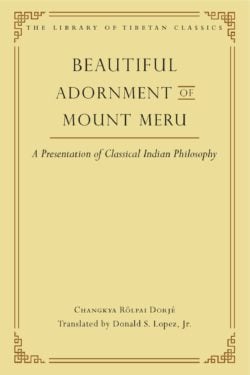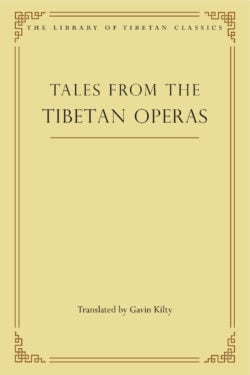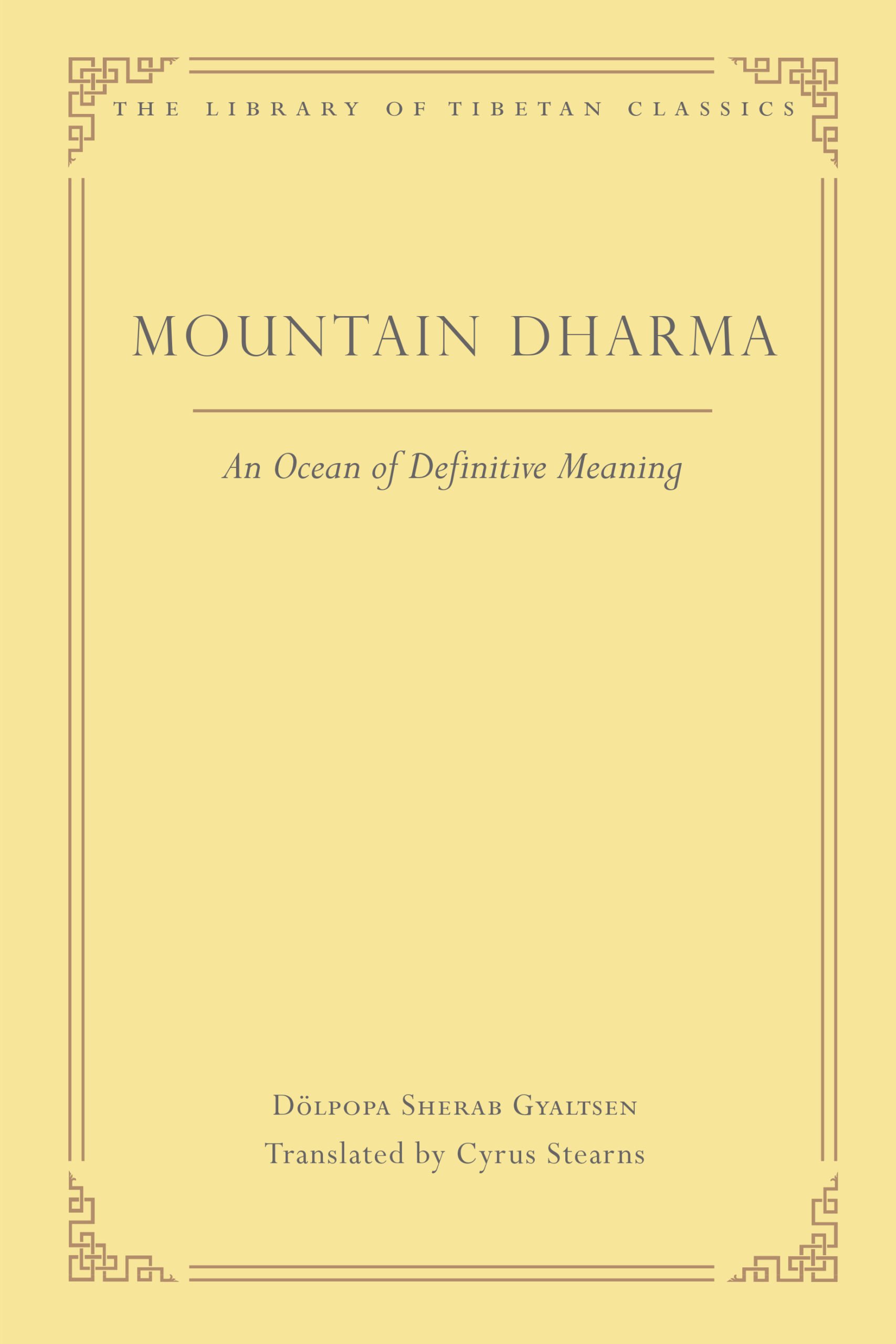
MOUNTAIN DHARMA
A brilliant annotated translation of Dölpopa Sherab Gyaltsen’s Mountain Dharma that opens a masterpiece of the Jonang tradition to Western readers and presents Dölpopa’s provocative ideas about a true, eternal, and established reality that still impact Buddhism today.
The controversial master Dölpopa Sherab Gyaltsen shook Buddhist Tibet when he taught that an eternal enlightened essence, or buddha nature, exists in full form in all living beings. The ideas discussed in Mountain Dharma are still as provocative as when Dölpopa first taught them, impacting Buddhism to this day. Dölpopa identified the ultimate with the buddha nature, or sugata essence, which he held to be eternal and not empty of self-nature. The buddha nature is perfect, with all its characteristics inherently present in all living beings. It is only the impermanent and temporary afflictions veiling the buddha nature that are empty of self-nature and must be removed through the practice of the path to allow it to manifest. Dölpopa establishes the validity of his theories with an ocean of quotations selected from Indian Buddhist scriptures and treatises of indisputable authority, showing us that the ultimate is a true, eternal, and established reality, empty merely of other relative phenomena.
Learn more about the Library of Tibetan Classics
Learn about becoming a benefactor of the Library of Tibetan Classics
- Hardcover
- 720 pages, 6 x 9 inches
- $79.95
- ISBN 9780861714469
- eBook
- 720 pages
- $59.99
- ISBN 9781614298076
Discover More
The Perfection of Wisdom Tradition
The perfection of wisdom (prajñāpāramitā) is a key element of the path in Mahāyāna Buddhism. Wisdom here is the transcendent wisdom of a bodhisattva who has penetrated the nature of reality, the emptiness (śūnyatā) of all things. Sutras that take the Perfection of Wisdom as their name emerged in the centuries before and after the start of the Common Era and became foundational for the nascent Mahāyāna. These include the well-known Heart Sūtra and Diamond Cutter Sūtra as well as the Perfection of Wisdom sutras in eight thousand and a hundred thousand lines.
Study of the Perfection of Wisdom sutras in Tibet has historically been through commentaries on the Ornament for the Clear Realizations (Abhisamayālaṃkāra), a short verse distillation in eight chapters attributed to Maitreya that was expanded in India by such figures as Asaṅga, Haribhadra, and Ārya-Vimuktisena. The three works in the present volume reflect the diversity of the Tibetan commentarial tradition on these Indian works.
Ngok Loden Sherab’s (1057–1109) Topical Summary marks the beginning in Sangphu Monastery of the most influential Perfection of Wisdom commentarial tradition. Ngok’s short work leads the reader briskly through the Abhisamayālaṃkāra’s seventy topics, presenting what would become the standard framework for explaining the Perfection of Wisdom in Tibet. The entirety of Haribhadra’s Vivṛti commentary has been embedded in Ngok’s text.
Gyaltsab Darma Rinchen’s (1364–1432) Way to Practice the Sequence of Clear Realizations, structured as a defense of the meditation system set forth by his guru Tsongkhapa in the Great Treatise on the Stages of the Path to Enlightenment, links the stages of the path expanded into the seventy topics with the actual practices of an accomplished yogi. Working outward from the middle of the Abhisamayālaṃkāra’s fourth chapter, it explains how the Perfection of Wisdom is integrated into a total and complete meditational practice for the attainment of buddhahood.
The great Drukpa Kagyü scholar Kunkhyen Pema Karpo’s (1527–92) Sacred Words of Lord Maitreya is the most detailed and systematic of the three works, supplementing explanations of the Perfection of Wisdom based on the Abhisamayālaṃkāra with verses from the Mahāyānasūtrālaṃkāra (Ornament for the Mahāyāna Sūtras) and the Uttaratantra (Sublime Continuum). This work as presented here includes within it a complete translation of the Abhisamayālaṃkāra’s eight chapters.
Learn more about the Library of Tibetan Classics
Learn about becoming a benefactor of the Library of Tibetan Classics
Buddhist Epistemology in the Geluk School
Faced with Buddhism’s radical interdependence, one might ask, “If everything is relative, how can I be certain of anything?” Here, the descendents of Tsongkhapa plumb the nature of knowing and the tools of reasoning to come up with an answer.
This volume includes translations of three separate Tibetan works by iconic figures in the Geluk school of Buddhism. The first work, Banisher of Ignorance, is by Khedrup Gelek Palsang (1385–1438), and the second, On Preclusion and Relationship, is by Gyaltsab Darma Rinchen (1364–1432). The authors—popularly known as Khedrup Jé and Gyaltsab Jé—were the foremost disciples of the Geluk-school founder, Tsongkhapa Losang Drakpa (1357–1419). The third text, Mighty Pramāṇa Sun, is a commentary on Candrakīrti’s Clear Words (Prasannapadā) by the First Jamyang Shepa (1648–1721).
These works concern themselves primarily with the Buddhist theory of knowledge—the means by which we are able to know things and how we can be certain of that knowledge. Encapsulating this theory is the notion of pramāṇa, a concept derived from India, the Buddhist understanding of which was shaped most significantly by the masters Dignāga (fifth to sixth century) and Dharmakīrti (seventh century). Based on their explanation, pramāṇa is often translated as “valid cognition,” a literal reference to the kind of cognition that they proposed could be relied upon to supply indisputable knowledge. In recognition of the crucial role that reasoning is held to play in gaining certain knowledge, the Buddhist Pramāṇa tradition is described as a logico-epistemological system.
The works in this volume demonstrate how important scholastic rigor has been to Tibetan religion. They illustrate how those who follow the tradition have viewed the systematic approach as necessary not only for textual analysis—for those seeking to unravel the complexities of the Indian Buddhist scriptures and treatises—but also for practitioners aiming to progress along the spiritual path and achieve the higher Buddhist goals.
Learn more about the Library of Tibetan Classics
Learn about becoming a benefactor of the Library of Tibetan Classics
Sakya Paṇḍita
A set of classic biographies of Sakya Paṇḍita—one of Tibet’s greatest scholars and religious masters.
Sakya Paṇḍita Kunga Gyaltsen (1182–1251) was a renowned Tibetan polymath, scholar, statesman, and religious master, and one of the most famous and consequential figures in the history of Tibet. The three classic biographies included here contain fascinating firsthand accounts of key events in Sakya Paṇḍita’s life, covering his family ancestry, early education, interactions and debates with other sects, travels to Mongolia and his diplomacy at the Mongol court, and a detailed account of the miraculous events that occurred in the last weeks of his life.
The Fundamental Practices
A wise and warm guide to the preliminary practices that lay the fundamental groundwork for traversing the path to buddhahood.
When we start on the transformational journey to enlightenment, we need a strong foundation in core Buddhist principles and practices to set us on the right track. The ngöndro, or preliminary practices, are that very foundation; they not only prepare us for advanced practice but serve us in all we do. In this guide to the common and uncommon preliminary practices, His Holiness the Forty-Second Sakya Trizin, Ratna Vajra Rinpoche, expertly gives us the grounded, practical, and illuminating teachings we need to set out on the path to buddhahood. Newcomers and seasoned practitioners alike will find practical guidance and profound wisdom to support them through their exploration of the preliminary practices.
The common preliminary practices are the four thoughts that turn the mind away from the suffering of samsara and toward the Dharma: remembering the shortcomings of samsara, remembering the preciousness of a human rebirth, remembering impermanence, and remembering the law of karma. These teachings are shared among traditions and will accompany us all the way to buddhahood. The five uncommon preliminary practices are core to further Mahayana and Vajrayana practice: going for refuge in the Buddha, Dharma, and Sangha; developing bodhichitta, the enlightened mind; Vajrasattva practice, which clears negative karma; mandala offering, which will help us accumulate merit; and guru yoga, which facilitates our realization of the nature of mind.
By using this guide, we can develop a deeper understanding of what Dharma practice truly encompasses and how we can authentically engage in it. His Holiness the Forty-Second Sakya Trizin invites us to appreciate the profound significance of these preliminary practices and experience the transformative benefits they offer—for both ourselves and all sentient beings.
The Amazing Treasury of the Sakya Lineage
A lucid and landmark translation that offers an intriguing glimpse into Tibetan history, the Mongol Empire, and the spiritual development and remarkable lives of the early luminaries of the Sakya lineage of Tibetan Buddhism.
In this first of two volumes of The Amazing Treasury of the Sakya Lineage, translators Khenpo Kunga Sherab and Matthew King capture a truly remarkable period in Buddhist and Asian history. Here, Ameshab Ngakwang Kunga Sönam (1597–1659), a member of the Khön aristocracy and the twenty-seventh throne holder of Sakya Monastery, offers a narrative that recounts the lives of numerous iconic leaders of the Sakya school of Tibetan Buddhism during the transformational period between the tenth and fourteenth centuries. This landmark volume reconstructs that long era of religious and political innovation and upheaval through the rise of the Mongol Empire.
In this book, you’ll see how Sakya Buddhist leaders emerged in this early period as translators, adopters, arbiters, and innovators of newly circulating Indian Buddhist scholastic and tantric cultures. In the thirteenth century, when the Mongol Empire forever transformed medieval Eurasia, leaders of the Sakya school became confidants and tutors to some of its most powerful leaders. The biographies of numerous Sakya luminaries are retold here, like Sakya Paṇḍita and Phakpa Lodrö Gyaltsen; along with their Mongol contemporaries, Köten Ejen and Qubilai Qaγan, these leaders laid the groundwork for forms of patronage, religious and political sovereignty, scholasticism and tantrism, and righteous rule that would endure for the next eight centuries down to today.
Reality and Wisdom
Written in a warm and accessible style by one of today’s most respected Tibetan Buddhist masters, Reality and Wisdom leads the reader on a journey of discovery beginning with the very first teachings of the Buddha and into the profound experience of emptiness.
The first section of the book explores the bedrock Buddhist teachings of the four noble truths—insights into freedom from suffering from craving—which underpin all schools of Buddhism. Lama Migmar presents and explores these foundational Buddhist truths with humor and insight, explaining how, from a Mahayana Buddhist perspective, these truths serve as crucial supports for cultivating the transformative wisdom of emptiness.
In the book’s second half, Lama Migmar illuminates the terse and enigmatic lines of the Heart Sutra, perhaps the most studied and revered of all Mahayana Buddhist scriptures. The Heart Sutra presents the reader with a vision of reality as it is perceived by a buddha, a vision underpinned by and infused with the radical flexibility and possibility of emptiness and the engagement and responsiveness of profound compassion.
The clarity, warmth, and vibrancy of Lama Migmar’s writing combined with the comprehensiveness and detail of his presentations of key Buddhist teachings make this book a valuable resource for a range of readers, from beginners to more advanced practitioners seeking to deepen their practice.
The Tradition of Everlasting Bön
This authoritative annotated translation of five key texts of Everlasting (Yungdrung) Bön by Marc des Jardins opens up a relatively unknown tradition, which since the arrival of Buddhism in Tibet has undergone great transformations in its philosophy, doctrinal teachings, and meditative practices.
The texts each represent an important aspect of the tradition. The first text, by Drogön Azha Lodrö Gyaltsen (1198–1263), presents the grounds and paths of the Greater Vehicle of the Bön tradition and represents the philosophical ideology of its teachings based on the scriptures contained in the Bön canon. The second text is a short root tantra attributed to revealed teachings from Kuntu Zangpo, the personification of the unconditioned absolute. The third text is a commentary on this root tantra attributed to Drenpa Namkha (fl. eighth century), a Bönpo sage contemporary with Padmasambhava. The fourth text, by Nyamé Sherap Gyaltsen (1356–1415), presents a general exposition of the tantric system according to Yungdrung Bön. The final text, by Drutön Gyalwa Yungdrung (1242–90), pertains to the oral instructions on the meditation practices of Bön, especially on the cycle of practices associated with experiencing the nature of the mind, the Great Perfection systems. All five texts have been selected by the late H. H. Menri Trizin Rinpoché, Lungtok Tenpai Nyima (1927–2017), the thirty-third abbot of Menri Monastery, the central institution of the Yungdrung Bön school.
Learn more about the Library of Tibetan Classics
Learn about becoming a benefactor of the Library of Tibetan Classics
Light of Samantabhadra
A gateway to Indian philosophy and its explication in Tibet.
Among the many works produced in the rich philosophical tradition of India’s classical age, few have had more impact than Dharmakīrti’s Commentary on Valid Cognition (Pramāṇavārttika). Composed in India in the seventh century, it became the cornerstone for the study of logic and epistemology in the Tibetan Buddhist tradition.
This work translated here is by one of the premier scholars of the Sakya school, Gorampa Sönam Sengé (1429–89). It illuminates the first two chapters of Dharmakīrti’s work, those on using inference to enlighten oneself (svārthānumāna) and on establishing valid cognition (pramāṇasiddhi) both to determine the authority of the Buddha as a valid teacher and to eliminate the cognitive obstacles to awakening. The root text is composed in compact verses, and these are translated here along with Gorampa’s word-by-word commentary that reveals their often veiled meanings. These chapters explore key issues in the philosophy of language and the nature of conventional designation, the way to employ sound reasoning, the proof of past and future lives, and the way to eliminate the view of self. In the skilled hands of translator Gavin Kilty, these insights are made accessible.
Light of Samantabhadra is the first volume in a new academic series from Wisdom and the Khenpo Appey Foundation. The Khenpo Appey Collection of Sakya Classics aspires to fulfill Khenchen Appey Rinpoche’s vision of making important and authoritative Sakya works accessible to English-speaking audiences. This series, conceived by the Khenpo Appey Foundation and published by Wisdom Publications, will contain translations of texts central to Tibetan Buddhist study composed by influential Sakya masters to provide a holistic and comprehensive presentation of Buddhist thought and philosophy.
Stages of the Path and the Oral Transmission
A major contribution to the literature on Buddhist practice according to the Geluk school of Tibetan Buddhism from its foremost interpreter.
Although it was the last major school to emerge in the Tibetan Buddhist tradition, the Geluk school has left an indelible mark on Buddhist thought and practice. The intellectual and spiritual brilliance of its founder, the great Tsongkhapa (1357–1419), has inspired generations of scholars and tantric yogis to place him at the heart of their daily meditative practice. The Geluk tradition’s close ties to the Dalai Lamas have also afforded it an outsized influence in all aspects of Tibetan life for centuries. At its peak, its combined monasteries boasted a population in the tens of thousands, and its sway encompassed the religious landscape of Mongolia and much of Central Asia.
This widespread religious activity fostered a rich literary tradition, and fifteen seminal works are featured here representing four genres of that tradition. The first are works on the stages of the path, or lamrim, the genre for which the Geluk is most renowned. Second are works on guru yoga, centered around the core Geluk ritual Offering to the Guru (Lama Chöpa). Third are teachings from the unique oral transmission of Geluk mahāmudrā, meditation on the nature of mind. Fourth are the “guide to the view” (tatri) instructions. The volume features well-known authors like Tsongkhapa, the First Panchen Lama, and the Fifth Dalai Lama, but also important works from lesser-known figures like Gomchen Ngawang Drakpa’s stages of the path in verse and Gyalrong Tsultrim Nyima’s extensive commentary on the Lama Chöpa that interweaves precious explanations from the Ensa Oral Tradition he received from his own teacher.
Your guide to these riches, Thupten Jinpa, maps out their historical context and spiritual significance in his extensive introduction.
Learn more about the Library of Tibetan Classics
Learn about becoming a benefactor of the Library of Tibetan Classics
A History of Buddhism in India and Tibet
The first complete English translation of an important thirteenth-century history that sheds light on Tibet’s imperial past and on the transmission of the Buddhadharma into Central Asia.
Translated here into English for the first time in its entirety by perhaps the foremost living expert on Tibetan histories, this engaging translation, along with its ample annotation, is a must-have for serious readers and scholars of Buddhist studies. In this history, discover the first extensive biography of the Buddha composed in the Tibetan language, along with an account of subsequent Indian Buddhist history, particularly the writing of Buddhist treatises. The story then moves to Tibet, with an emphasis on the rulers of the Tibetan empire, the translators of Buddhist texts, and the lineages that transmitted doctrine and meditative practice. It concludes with an account of the demise of the monastic order followed by a look forward to the advent of the future Buddha Maitreya.
The composer of this remarkably ecumenical Buddhist history compiled some of the most important early sources on the Tibetan imperial period preserved in his time, and his work may be the best record we have of those sources today. Dan Martin has rendered the richness of this history an accessible part of the world’s literary heritage.
Learn more about the Library of Tibetan Classics
Learn about becoming a benefactor of the Library of Tibetan Classics
Sounds of Innate Freedom, Vol. 4
Sounds of Innate Freedom: The Indian Texts of Mahāmudrā are historic volumes containing many of the first English translations of classic mahamudra literature. The texts and songs in these volumes constitute the large compendium called The Indian Texts of the Mahāmudrā of Definitive Meaning, compiled by the Seventh Karmapa, Chötra Gyatso (1456–1539). The collection offers a brilliant window into the richness of the vast ocean of Indian mahamudra texts cherished in all Tibetan lineages, particularly in the Kagyü tradition, giving us a clear view of the sources of one of the world’s great contemplative traditions.
Besides the individual dohās (couplets), vajragītis (vajra songs), and caryāgītis (conduct songs) in this second volume in publication, the three extensive commentaries it contains brilliantly unravel enigmas and bring clarity not only to the specific songs they comment on but to many other, often cryptic, songs of realization in this collection. These expressive songs of the inexpressible offer readers a feast of profound and powerful pith instructions uttered by numerous male and female mahāsiddhas, yogis, and ḍākinīs, often in the context of ritual gaṇacakras and initially kept in their secret treasury. Displaying a vast range of themes, styles, and metaphors, they all point to the single true nature of the mind—mahāmudrā—in inspiring ways and from different angles, using a dazzling array of skillful means to penetrate the sole vital point of buddhahood being found nowhere but within our own mind. Reading and singing these songs of mystical wonder, bliss, and ecstatic freedom, and contemplating their meaning, will open doors to spiritual experience for us today just as it has for countless practitioners in the past.
Click here to explore other volumes available in The Sounds of Innate Freedom series.
Four Tibetan Lineages
The newest translation from master translator Sarah Harding.
Drawing primarily from the Pacification, Severance, Shangpa Kagyü, and Bodongpa traditions, Four Tibetan Lineages presents some of Tibet’s most transformative yet lesser-known teachings on meditative practice. Most works in this volume are drawn from a Tibetan anthology known as the Treasury of Precious Instructions compiled by Jamgön Kongtrul Lodrö Thayé (1813–1900). A vast preservation project, this anthology reflects Kongtrul’s attempt to rescue rare teachings from disappearing. By foregrounding the teachings of masters like Khedrup Khyungpo Naljor (d. 1135), Dampa Sangyé (d. 1117), Machik Labdrön (1031/55–1126/50), Jonang Tāranātha (1575–1634), and Jamyang Khyentsé Wangpo (1820–92), this volume extends Jamgön Kongtrul’s preservation efforts into the modern world.
Learn more about the Library of Tibetan Classics
Learn about becoming a benefactor of the Library of Tibetan Classics
The Play of Mahamudra
“This new collected edition of Khenpo Migmar Tseten’s Play of Mahamudra volumes constitutes a veritable treasure for all who are deeply engaged on the path to enlightenment. Khenpo Migmar’s translation of Mahasiddha Virupa’s Treasury of Dohas and of Sachen Kunga Nyingpo’s Praise to Virupa makes us intimately familiar with the essence of these root texts, and his elucidation of the Dohas offers us a deep and clear understanding of their core meaning. Anyone who truly contemplates on Mahasiddha Virupa’s words is certain to attain realization.”
—His Holiness the Sakya Trichen
In this collection, renowned Tibetan Buddhist teacher Lama Migmar Tseten provides essential commentary on the mystical songs of the Indian Buddhist rebel-saint Virupa. One of the most celebrated tantric masters of Buddhist India, Virupa’s songs describe his realization of mahamudra, the ultimate nature of reality. Intimate and highly engaging, The Play of Mahamudra unpacks these songs with meticulous clarity, making Virupa’s insights accessible to modern readers.
The Bodhisattva Path from Ground to Fruition
Discover profound teachings on the Buddhist path from His Holiness the 42nd Sakya Trizin Ratna Vajra, one of Tibetan Buddhism’s most prominent leaders.
His Holiness Ratna Vajra Rinpoche is one of Tibetan Buddhism’s most highly qualified teachers, having received all the major empowerments, transmissions, and teachings directly from his father, Gongma Trichen Rinpoche, the forty-first Sakya throne holder and one of the most senior teachers of the Sakya tradition. Following in the footsteps of his forefathers, His Holiness is renowned for the purity of his transmission, always taking great care to offer to his disciples the teachings as he faithfully received them. To the great fortune of his non-Tibetan-speaking students, His Holiness is also fluent in English, giving them a direct access to his teachings.
In this book, His Holiness offers profound commentary on Sakya Paṇḍita’s Clarifying the Sage’s Intent, one of Tibet’s most revered works on the bodhisattva path. Elucidating Sakya Paṇḍita’s teachings in exquisite detail, His Holiness describes the ground of Buddhist practice as the spiritual potential for liberation that is present in the hearts of all beings. He outlines the foundational practices of taking refuge and cultivating the resolve to become awakened, before detailing the six perfections, the levels of accomplishment of bodhisattvas, and the fruition of practice as a fully awakened buddha.
Illuminating the Intent
This work is perhaps the most influential explanation of Candrakirti’s seventh-century classic Entering the Middle Way (Madhyamakavatara).
Written as a supplement to Nagarjuna’s Fundamental Verses on the Middle Way, Candrakirti’s text integrates the central insight of Nagarjuna’s thought—the rejection of any metaphysical notion of intrinsic existence—with the well-known Mahayana framework of the ten levels of the bodhisattva, and it became the most studied presentation of Madhyamaka thought in Tibet.
Completed the year before the author’s death, Tsongkhapa’s exposition of Candrakirti’s text is recognized by the Tibetan tradition as the final standpoint of Tsongkhapa on many philosophical questions, particularly the clear distinctions it draws between the standpoints of the Madhyamaka and Cittamatra schools.
Written in exemplary Tibetan, Tsongkhapa’s work presents a wonderful marriage of rigorous Madhyamaka philosophical analysis with a detailed and subtle account of the progressively advancing mental states and spiritual maturity realized by sincere Madhyamaka practitioners.
The work remains the principal textbook for the study of Indian Madhyamaka philosophy in many Tibetan monastic colleges, and it is a principal source for many Tibetan teachers seeking to convey the intricacies of Madhyamaka philosophy to non-Tibetan audiences.
Though it is often cited and well known, this is the first full translation of this key work in a Western language.
Learn more about the Library of Tibetan Classics
Learn about becoming a benefactor of the Library of Tibetan Classics
Freeing the Heart and Mind: Volume 3
Collected from teachings by His Holiness, this book is a warm and comprehensive introduction to the Buddhist path as told by the patriarch of the Sakya order. His Holiness offers explanations of the philosophical tenets of the Mahayana path and in particular the Sakya school of Tibetan Buddhism—giving down-to-earth advice for practicing in the world today, including
- the principles of tantra,
- the value of retreat,
- the history of the Sakya lineage,
- ecology from a Buddhist perspective,
- biographies of great women practitioners,
- and other fascinating topics.
This is a must-read for anyone interested in following a Buddhist spiritual path.
Beautiful Adornment of Mount Meru
The lucid literary style of Beautiful Adornment of Mount Meru has made it a classic in the study of Indian philosophical thought, both in Tibetan monasteries and contemporary academic circles.
Beautiful Adornment of Mount Meru is a work of doxography, presenting the distinctive philosophical tenets of the Indian Buddhist and non-Buddhist schools in a systematic manner that ascends through increasingly more subtle views. It is a Tibetan corollary to contemporary histories of philosophy. The “Mount Meru” of the title is the Buddha’s teachings, and Changkya’s work excels in particular in its treatment of the two Mahayana Buddhist schools, the Yogācāra (here called the Vijñaptimātra) and the Madhyamaka. Beautiful Adornment is often praised for the clarity of its prose and its economical use of citations from Indian texts. It skillfully examines core philosophical issues, supplemented with several intriguing ancillary discussions, and draws heavily on the works of Tsongkhapa and his disciples in the Geluk tradition he founded.
Learn more about the Library of Tibetan Classics
Learn about becoming a benefactor of the Library of Tibetan Classics
Tales from the Tibetan Operas
In Tales from the Tibetan Operas, timeless Buddhist ideas are brought to life through enchanting myths and vivid stories. Poetically vibrant, these eight classic lhamo stories have continued to delight and edify Tibetan audiences of all backgrounds, from village children to learned scholar-monks and Dalai Lamas.
Western readers can now get a glimpse into ancient Indian and Tibetan mythology through the cultural touchstone of eight classic lhamo stories. On visual display are the human and nonhuman characters of history and folklore — kings, queens, conniving ministers, ordinary folk, yogis, monks, and powerful beings from other realms such as gods and nāgas — engaged in plotting, kidnapping, fighting, journeys to faraway lands, separation, and reconciliation, often with a quest for seemingly impossible treasure. The suspenseful tales have many dramatic plot twists, but they all end in happiness, where the good achieve their goals and the bad receive their just desserts. The operas thus bring to the people the fundamental ethical laws of behavior and teachings of natural justice based on Buddhist doctrine.
The book features more than 50 gorgeous photos of the operas performed on location in Tibet and India.
Learn more about the Library of Tibetan Classics
Learn about becoming a benefactor of the Library of Tibetan Classics


